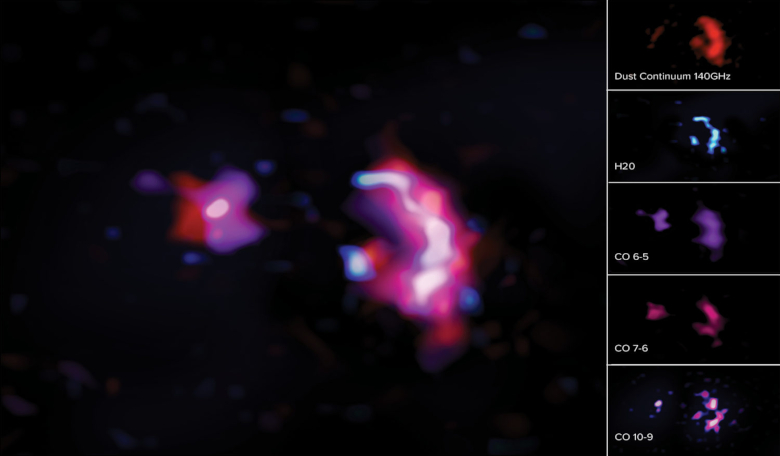Astronomers using the Atacama Large Millimeter/submillimeter Array (ALMA) have detected water and carbon monoxide (CO2) in a massive galaxy nearly 12.88 billion light years from Earth; this is the most distant detection of H20 in a regular star-forming galaxy and the most detailed study of molecular gas content of a galaxy in the early Universe to date.
A few hundred million years after the Big Bang, back when the Universe was young, logic suggests that the first galaxies to form would be small, like some of the dwarf galaxies we see in the nearby Universe today. Eventually these galaxies would merge to become much larger galaxies that came to dominate the Universe after the first few billion years.
But a few years ago, studies showed massive, star-filled galaxies seen when the Cosmos was less than a billion years old.
Those galaxies, also spotted with ALMA, were SPT0311-58; two very distant and extremely dusty galaxies that originally were thought to be one source. However after further observations, scientists determined they were actually two galaxies that are probably merging and likely going through a burst of star formation.
Scientists are seeing SPT0311-58 as it was in the Epoch of Reionization. This epoch occurred at a time when the Universe was just 780 million years old—roughly 5-percent of its current age—and the first stars and galaxies were being born.
But despite this youthful age, it appears galaxies were already pumping out molecules shortly after the elements were forged in early stars.
“Oxygen and carbon, in particular, are first-generation elements, and in the molecular forms of carbon monoxide and water, they are critical to life as we know it,” said Sreevani Jarugula, an astronomer at the University of Illinois and the principal investigator on the new research. “This galaxy is the most massive galaxy currently known at high redshift, or the time when the Universe was still very young. It has more gas and dust compared to other galaxies in the early Universe, which gives us plenty of potential opportunities to observe abundant molecules and to better understand how these life-creating elements impacted the development of the early Universe.”
As it turns out, the larger of the two galaxies in SPT0311-58, is forming stars at a rate of 2,900 solar masses per year. It also contains about 270 billion times the mass of our Sun in gas and nearly 3 billion times the mass of our Sun in dust. Its slightly smaller companion on the other hand hosts about 35 billion solar masses of stars.
It is likely that a close encounter between the two galaxies in SPT0311-58 is what is fuelling the frenzied star formation. In turn, UV photons emitted from the stars is being absorbed by the whopping amounts of dust contained in the galaxies. The dust then absorbs the ultraviolet radiation from the stars in the galaxy and re-emits it as far-infrared photons, Jarugula says.
“This further excites the water molecules, giving rise to the water emission that scientists are able to observe. In this case, it helped us to detect water emission in this massive galaxy. This correlation could be used to develop water as a tracer of star formation, which could then be applied to galaxies on a cosmological scale.”
Understanding how the first galaxies formed in the Universe also helps scientists shed light on the evolution of our own Solar System, Jarugula says.
“Early galaxies are forming stars at a rate thousands of times that of the Milky Way. Studying the gas and dust content of these early galaxies informs us of their properties, such as how many stars are being formed, the rate at which gas is converted into stars, how galaxies interact with each other and with the interstellar medium, and more.”











